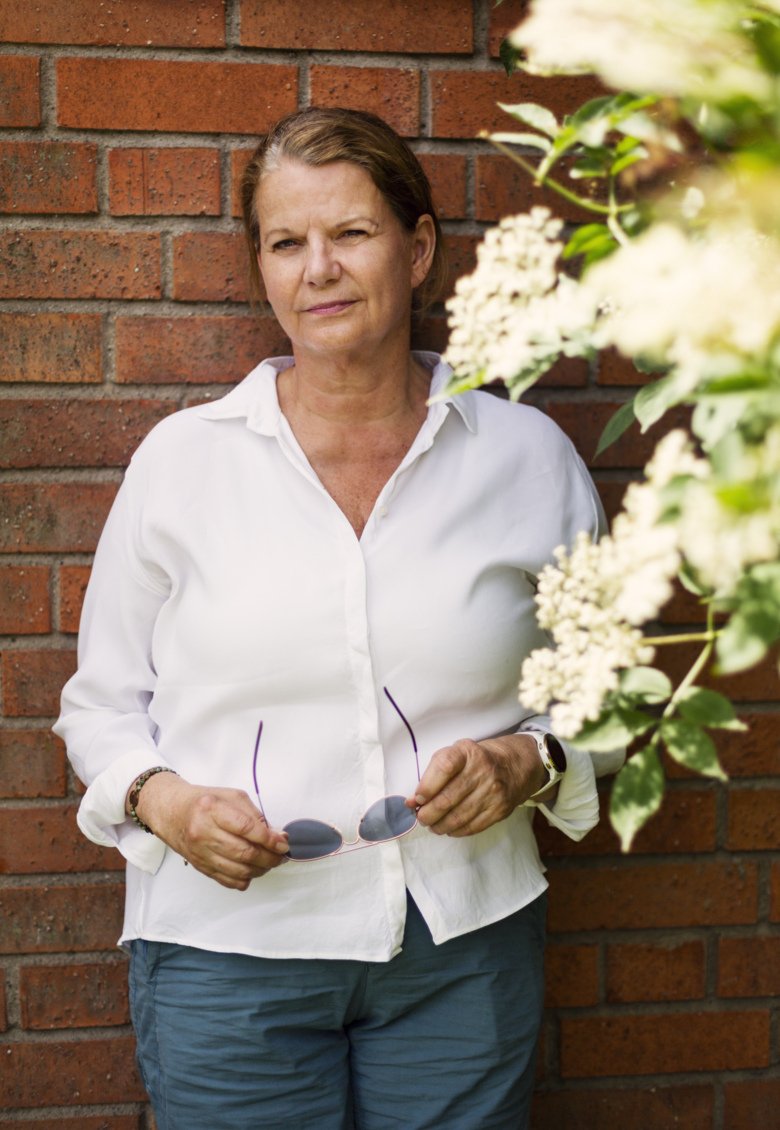She wants to see more good managers
Irene Jensen is a professor who knows everything there is to know about what makes a good working environment. But when she became a head of a team herself, it wasn’t easy at first. Now she wants to use AI to help improve managers’ leadership skills.

Text: Cecilia Odlind, first published in Swedish in Medicinsk Vetenskap, No 3/2021.
When Irene Jensen became a manager in the 2000s, she was enthusiastic at first. But it took time to find her feet in the role.
“At first, I didn’t really have the courage to be a manager, I wanted to carry on being part of the group,” she says.
When that didn’t work, she switched to a more demanding goal-orientated leadership. But this wasn’t a long-term solution either.
“Admittedly, things got done. But there wasn’t a good atmosphere. It was stressful when I noticed that it wasn’t enough to just be myself,” she explains.
She is now a professor in occupational health practices at the Institute of Environmental Medicine at Karolinska Institute. She has studied the working environment in many workplaces during her career. So, what makes a good workplace? There’s certainly plenty of research on the subject.
“To have control over your working situation is a factor that has repeatedly been shown to be very important. This should be balanced against the requirements of the manager and the business,” she says.
Leadership is also clearly something that has an impact. Thoughtful and trusting leadership has proved most effective. Caring about your colleagues and seeing them as resources rather than as robots that must produce things for you. But getting support from colleagues is just as important.
“Good employee relations are almost more important than support from the manager. You can put up with a “bad manager” for quite some time if there’s a good atmosphere among the co-workers.”
Finally, the physical working environment is important. In Sweden, this is generally very good. However, there are still problems with heavy lifting and stressful working postures in some industries, such as care, according to Irene Jensen. Her research has focused on how these factors affect health.
“When these factors are absent, they all contribute to the risk of employees going on sick leave. The less these factors are valued, the longer you risk being on sick leave,” explains Irene Jensen.
A good working environment
Extensive research has therefore been conducted into what constitutes a good working environment looks. But what needs to be done in order to achieve it? A large study led by Irene Jensen carried out across several manufacturing industries in the 2000s taught her that you should not be afraid of asking employees how they’re doing even on a more personal level.
“Many people said that we couldn’t ask questions about issues such as mental health or alcohol consumption, as they believed this would be an invasion of privacy. But afterwards, the reaction among the employees was positive; they felt like someone finally cared about how they were really feeling. One condition is that you provide resources at the same time to give support to those who need it,” she explains.
Irene Jensen also studies how best to publicise research-based knowledge. In a study on increasing the use of evidence-based methods in occupational healthcare, her research group and users developed national evidence-based guidelines for occupational health. Today, these guidelines are administered by the Swedish Agency for Work Environment Expertise.
“It was truly going from research to practice. All of us who carried out the study are very proud of that,” says Irene Jensen.
Another way to influence a business is to introduce a clear leadership strategy, i.e. one which defines what kind of managers people want.
“This is implemented right from recruitment, so that new managers who are appointed correspond to the chosen manager type. Those who are appointed must also be trained. And you need to be willing to transfer managers who don’t practise the right leadership style,” explains Irene Jensen.
Research has shown that clear and well-anchored systematic work environment management not only creates companies with good working environments, but also leads to high productivity. But again – it’s important that the atmosphere also allows employees to take personal responsibility for their situations.
“You can’t place all the responsibility on managers; it’s a shared job that has to be done,” she says.
She points out that the research industry, which she herself works in, presents particular difficulties, as it’s extremely competitive. This challenges social relationships and increases the risk of bullying. Considerate and good leadership is even more important here.

Irene Jensen’s research is carried out in collaboration with the occupational health services and various workplaces, and this imposes specific requirements on the work, according to her.
“As a researcher, it’s easy to forget that you can’t just go in and collect information, you also need to give something back. If we require time and engagement from managers and employees, then we also need to be able to adapt our questions and study design to each specific workplace,” she says.
The project results also can’t be dragged out for too long, as the employees will want to gain useful insight from their participation.
“The methodology is important, of course, but if you want to make use of the results in the business, you also need to collaborate. It takes time away from the pure research, and we’ve shown in a study that this amounts to twice the cost per research publication. However, making use of the results and implementing them is very important; that’s the point of the research at the end of the day,” explains Irene Jensen.
Robot can support in leadership
Implementation, publicising all available knowledge on how to create a good working environment, is something she’s passionate about. She therefore hopes to develop Sam, an intelligent robot which will use AI to share knowledge and give support to managers.
“All information is usually written down in various PDF documents in the organisations’ intranet. But it’s then important to find it, read it and put it into practical use in the situation the manager is facing at that particular moment, which is something you might not always be able to do as a manager,” she says.
Sam, which is a Swedish abbreviation for systematic work environment management (systematiskt arbetsmiljöarbete), will act as a conversation partner, a coach.
“This could for example involve teaching the manager how important it is to tackle emerging conflicts at an early stage in order to avoid bullying issues. Or how best to rehabilitate someone who has hit a wall,” says Irene Jensen.
The project, called Speak with Sam, is still seeking some funding.
Irene Jensen herself has an illness that leaves her in constant pain. When she started doing yoga, she noticed that it both relieved her pain and reduced her stress levels. This inspired her to start researching the effects of yoga on back pain, among other things. Together with her colleagues, she conducted a randomised treatment study, which compared the effects of yoga with the effects of functional training at a gym on people with back pain.
“It’s well known that physical activity helps with pain and stress, and we could see this in both groups. But yoga was more cost-effective, as you can do it at home. There were also more people who continued doing yoga over time, probably because it’s easier to do. You only need a mat,” she says.
Back to the time when Irene Jensen became a manager herself. To develop her leadership skills, she got help from a mentor in order to find her leadership style.
“For me, fairness and equality are key issues. I also learnt that it’s important to be bold enough to be clear about what needs to be done for the good of the company; after all that’s what we’re working for. But this needs to happen in collaboration with the employees,” says Irene Jensen.
She’s a mentor herself these days and thinks more managers should get help.
“A good manager gets help rather than the other way around. It’s positive, it means that you want to develop,” says Irene Jensen.
Facts about Irene Jensen
Name: Irene Jensen.
Title: Professor of corporate health and research director at the Institute of Environmental Medicine, Karolinska Institute.
Age: 65.
Family: Two adult children, four grandchildren and a dog.
How I relax: By being in the countryside in Kilsbergen. Yoga and meditation. Reading fiction and painting. Walking and being with my grandchildren.
Inspired by: Emma Goldman, feminist and anarchist who blazed her own trail in a wonderful way.
Research for me: It’s not a career path; it’s a driving force to find answers to questions.
Best research characteristic: I’m precise and inquisitive and often ask the question “How do you know that?”.
Irene Jensen on…
… a good working environment:
You can immediately tell when you come into a workplace what the mood is. Are people laughing or sitting in silence? Do people respect each other? Are people proud of what they do?
… the difference between a manager and a leader:
A manager is the person who formally decides what should be done and how. But a leader is someone who gets a group to work together towards a common goal.
… occupational health economics:
Better tools are needed to measure the economic effects of work environment management on health, the working environment and performance at work.
… being a researcher and a woman
High demands are placed on you at the university. You have to be a researcher, teacher, project leader and manager. The responsibility for children and the household also often falls on the woman.
